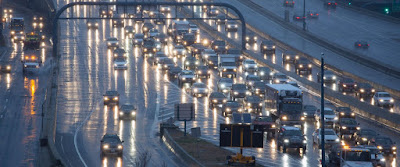 |
| Getty Images |
"All of these trips add an extra strain to an already overburden transportation system," said Transportation Secretary Anthony Foxx. "Some of the bottlenecks mentioned in today's report in fact are not all that surprising."
While weather problems, rush hour and even construction are sources of congestion, bottlenecks due to a lack of roads and poor infrastructure planning are the biggest and most consistent issue facing drivers in major metropolitan cities, according to a new report.
Interstate 90 around Chicago O'Hare International Airport is considered the worst bottleneck in the country, resulting in 16.9 million hours' worth of wasted time. That's an estimated $418 million of lost productivity a year, according to a new report from the American Highway Users Alliance.
The reason for the commuter agony? Too many people behind the wheel with not enough space to accommodate them, according to the report, which noted that the problem is getting worse. Hours of delay per traveler has doubled in cities all sizes since 1982, the report noted.
The report details the 50 worst bottlenecks in the country, with six of the top 10 choke points located in Los Angeles.
Also breaking into the top ten is the New York City area, which has nine chronic bottlenecks, with the 2.6 miles around the notorious Lincoln Tunnel resulting in 3.4 million hours of driver delays every year.
But bottlenecks can be fixed, the report shows. One spot in the nation that dropped off the list in the last 10 years is the Woodrow Wilson Bridge in the Washington, D.C., area. The bridge was rebuilt and traffic improved.
As for a solution, the report finds that fixing bottleneck problems means more investment in infrastructure. The study found that it will take a combination of new roads and mass transit systems, using state and federal funding to come up with the type of solutions that will save drivers time and money.
Bottlenecks were ranked based on backups in both directions over the entire day, not just one direction during rush hours.
As for the bottlenecks themselves, the study’s top 50 list includes trouble spots in the following Metropolitan Areas: 12 in Los Angeles, nine in and around New York City, three in Chicago, three near Washington, D.C., three in Houston, three in Boston, three in Dallas, three in Miami, two in Atlanta, two in Philadelphia, and two in San Francisco/Oakland.
The top ten worst spots along the nation's highways:
1. Chicago, Illinois - I-90 between Roosevelt Rd. and N. Nagle Ave.
2. Los Angeles, California - I-405 between SR-22 and I-605
3. Los Angeles, California - I-10 between Santa Fe Ave and Crenshaw Blvd.
4. Los Angeles, California - I-405 between Venice Blvd. and Wilshire Blvd.
5. Los Angeles, California - US-101 between Franklin Ave. and Glendale Blvd.
6. Los Angeles, California - I-110 between Exposition Blvd. and Stadium Way
7. Los Angeles, California - US-101 between Sepulveda Blvd. and Laurel Canyon Blvd.
8. New York and New Jersey - Lincoln Tunnel between 10th Ave. and John F. Kennedy Blvd.
9. New York, New York - I-95 between I-895 and Broadway
10. Austin, Texas - I-35 between East Riverside Dr. and E. Dean Keeton St.
0 Response to "Worst Traffic U.S. Bottlenecks"
Thanks for give comment.